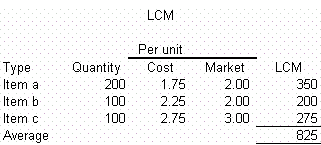A merchandise firm generally uses historical cost to value merchandise inventory and cost of goods sold. But sometimes it justifies a departure from the historical cost for many reasons.
This is where the utility or value of inventory item is less than its cost. This may happen due to a decrease in the selling price or replacement cost of merchandise inventory.
Companies should not carry goods inventory at more than their net realizable value.
Net realizable value is the estimated selling price of an item of goods less the estimated cost that the company incurs in preparing the item of goods for sale or selling.
Damaged, obsolete or shop born goods net realizable value often become lower than their historical costs. And these must be written down to their net realizable value.
Besides, technological changes, changes in fashion and increased competition do cause a significant reduction in the selling price of some products such as computers, calculators, ready-made clothes, toys etc.
To show a necessary write down in the cost of inventory, assuming that an electronics company has a television on hand which has been used for demonstration purpose.
The company acquired the television at a cost of $10,000.

The television has an original selling price of $ 13,000. Due to change of model, and also for the long use of the television, its present estimated selling price is only $9,500.
In such case, the television inventory is to be valued at $9,500. So, the loss due to fallen price is $500.
For inventory purpose necessary journal is;
| Debit | Credit | |
| $ | $ | |
| Loss due to fall in market price of inventory | 500 | |
| Merchandise inventory | 500 | |
| (To write down inventory to realizable market value.) |
Such entry for loss is necessary only when net realizable is less than cost.
If net realizable value declines but still exceeds cost, the company will continue to carry the inventory at cost.
The lower of cost or market (LCM) is a widely accepted inventory valuation method.
Under this method, the inventory is valued at the lower of its historical cost or its current market/replacement cost.
The term cost refers to the historical cost of inventory as determined by the specific identification, FIFO, LIFO or weighted average inventory method.
The market generally refers to a merchandise item’s replacement cost in the quantity usually purchased.
The basic assumption of the LCM method is that if the purchase price of an item falls, its selling price also falls or will fall. The LCM has long been accepted in accounting globally.
Under LCM, inventory items are written down to market value when the market value, is less than the cost of the items. For example, assume that the market value of the inventory is $50,000 and its cost is $55,000.
Then, the company would record a $5,000 loss because the inventory has lost some of its revenue – generating ability.
The company must recognize the loss in the period the loss occurred.
On the other hand, if ending inventory has a market value of $55,000 and a cost of $50,000, the company would not recognize this increase in value. To do so would recognize revenue before the time of sale.
The LCM can be applied to each item of inventory, to various sub groupings of inventory or to the inventory as a whole, as shown below: Inventory item no.
| No. | Description | Quantity | Cost (FIFO) | Market / Replacement cost | LCM item by item |
| 1 | Hose | 20 | 20 | 18 | 18 |
| 2 | Bracket | 40 | 40 | 41 | 40 |
| 3 | Clamp | 10 | 10 | 15 | 10 |
| 4 | Motor | 2 | 120 | 100 | 100 |
| 5 | Generator | 1 | 400 | 410 | 400 |
| 590 | 584 | 568 |
The LCM item-by-item column amounts are determined by comparing the cost and market for each item and choosing the lower of the two in each case.
These LCM item-by-item amounts are totaled and this amount, $568 is used to calculate the loss, as follows;
| $ | |
| Cost (FIFO) | 590 |
| LCM (item by item) | (568) |
| Loss | 22 |
The loss in value can also be estimated by comparing the total cost of the entire inventory with the total market of the entire inventory:
| $ | |
| Cost (FIFO) | 590 |
| Market (total inventory) | (584) |
| Loss | 6 |
A firm will choose whichever method – item-by-item or total inventory – is easier for it to use.
Either method of estimating the loss is acceptable, provided that it is used consistently from period to period. The loss will then be reported on the income statement either as a separate item or under the cost of goods sold.
The principle of conservatism is suitably applicable to the LCM rule.
Conservatism in accounting means that one should choose accounting methods that are least likely to overstate assets and income. Valuing inventory at cost when its replacement cost is lower overstates the asset merchandise inventory.
Thus, we apply the conservatism principle and use LCM to reduce inventory to a more realistic value and, at the same time, recognize the loss in value that has incurred.